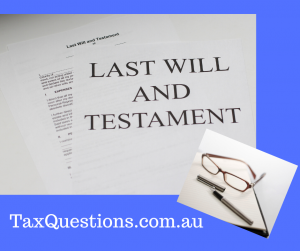When a superannuation fund pays out life insurance to a beneficiary or the estate it is called a death benefit payment. This payment will most likely be made up of a taxable portion and a non taxable portion. These two portions are joined at the hip. You cannot get one without the other. They are prorated if there is more than one beneficiary. For example if there are two equal beneficiaries then they each get half of the taxable portion and half of the non taxable portion. The taxable portion will not be subject to tax if it is received by the deceased’s spouse or minor children. The tax free portion is not subject to tax no matter who the beneficiary is whether direct or through the estate.
When an estate receives the superannuation it is the one to pay the tax but it is not a clear and simple choice which is the best way to go. The estate still has to look at how it is going to distribute the superannuation pay out. If it is going to distribute it to the spouse and minor children then it does not include it in its taxable income. It does not include the tax free portion in its taxable income but if the super payout is not going to the spouse or minor children then the taxable portion is included as income in the trust’s tax return.
So, so far you can see that there are no tricks in deciding who the super should be paid to unless the deceased has a spouse or minor children. The idea is to move as much of the taxable portion over to non taxable before you die. This can be done by a re contribution strategy once you qualify to withdraw your superannuation tax free but are still young enough to be allowed to put the money back into super. Contributions made into super for which no tax deduction has been claimed will increase the tax free component. Don’t try this without advice.

Now assuming you have a taxable component and adult children beneficiaries it is all about relative tax brackets. This takes a bit of crystal ball gazing but here is an idea of the issues. The 15% rebate and 30% cap apply whether the superannuation is paid to the adult child direct or through the estate. It is just in the case of the estate that the tax is paid by the estate first before it is passed onto the adult child. For the first 3 tax returns after death the estate gets the tax free threshold and stepped up tax rates but no Medicare Levy. So there is a good chance the estate will pay less tax than if the taxable portion was added onto the adult beneficiary’s income but this is not always the case. You need to consider other income the estate may have and the tax brackets of the beneficiaries. For example even if there was no other income in the estate if there were two beneficiaries who were both carers with no income then they may still be better to receive it personally. Or better still divvy it up amongst the estate and beneficiaries. Say you had one high income adult child and two zero income adult children, use a binding nomination to leave 1/3rd of the superannuation to your estate where the will gives it to the high income child and give the other two low income children 1/3 each of the super direct through the binding nomination. This should give you 3 tax free thresholds. The take away from this is that there is no one size fits all, you would need to constantly update your will and binding nomination to get it perfect and the difference may not be that much at all. It is probably more important to consider other issues first such as the way a binding nomination by passes the will which can be challenged. Nevertheless, that re contribution strategy done correctly has no negatives.
It is worth noting that it is not just a spouse or minor child that can receive your superannuation tax free. There is an interdependent test that has been known to be applied to pay a mother her son’s super tax free when he was killed. Based on the fact she lived with him and relied on him for support. This means in the case of 3 adult generations with Granny in the Granny flat it may be more tax effective to leave your superannuation to her than to your adult children. High level advice and trust here.
A TPD paid in your life time is not a death benefit so none of the above applies. The trick with TPD payments, if you are under 60, is to make sure the superannuation fund pays it out as an invalidity payment so it won’t be taxed.
This advice is very general about issues that vary with each individual’s circumstance so should only be relied on as food for thought.
 Ask Ban Tacs
Ask Ban Tacs 